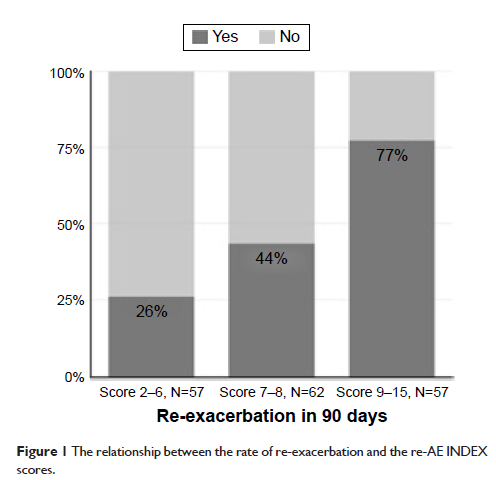9 5 9 0 3
论文已发表
注册即可获取德孚的最新动态
IF 收录期刊
- 3.3 Breast Cancer (Dove Med Press)
- 3.4 Clin Epidemiol
- 2.5 Cancer Manag Res
- 2.9 Infect Drug Resist
- 3.5 Clin Interv Aging
- 4.7 Drug Des Dev Ther
- 2.7 Int J Chronic Obstr
- 6.6 Int J Nanomed
- 2.5 Int J Women's Health
- 2.5 Neuropsych Dis Treat
- 2.7 OncoTargets Ther
- 2.0 Patient Prefer Adher
- 2.3 Ther Clin Risk Manag
- 2.5 J Pain Res
- 2.8 Diabet Metab Synd Ob
- 2.8 Psychol Res Behav Ma
- 3.0 Nat Sci Sleep
- 1.8 Pharmgenomics Pers Med
- 2.7 Risk Manag Healthc Policy
- 4.2 J Inflamm Res
- 2.1 Int J Gen Med
- 4.2 J Hepatocell Carcinoma
- 3.7 J Asthma Allergy
- 1.9 Clin Cosmet Investig Dermatol
- 2.7 J Multidiscip Healthc

已发表论文
对慢性阻塞性肺疾病急性发作 (AECOPD) 在短期内再度加重的预测
Authors Liu D, Peng SH, Zhang J, Bai SH, Liu HX, Qu JM
Published Date July 2015 Volume 2015:10(1) Pages 1265—1273
DOI http://dx.doi.org/10.2147/COPD.S83378
Received 23 February 2015, Accepted 28 April 2015, Published 2 July 2015
Approved for publication by Dr Richard Russell
Background: The objective of the study is to develop a scoring system for predicting a 90-day re-exacerbation in hospitalized patients with acute exacerbations of chronic obstructive pulmonary disease (AECOPD).
Methods: A total of 176 consecutive hospitalized patients with AECOPD were included. The sociodemographic characteristics, status before acute exacerbation (AE), presentations of and treatment for the current AE, and the re-exacerbation in 90 days after discharge from hospital were collected.
Results: The re-exacerbation rate in 90 days was 48.9% (86 out of 176). It was associated with the degree of lung function impairment (Global initiative for chronic Obstructive Lung Disease [GOLD] grades), frequency of AE in the previous year, and parameters of the current AE, including pleural effusion, use of accessory respiratory muscles, inhaled long-acting β-2-agonists, inhaled corticosteroids, controlled oxygen therapy, noninvasive mechanical ventilation, and length of hospital stay, but was not associated with body mass index, modified Medical Research Council scale, or chronic obstructive pulmonary disease assessment test. A subgroup of ten variables was selected and developed into the re-exacerbation index scoring system (age grades, GOLD grades, AE times in the previous year, pleural effusion, use of accessory respiratory muscles, noninvasive mechanical ventilation, controlled oxygen therapy, inhaled long-acting β-2-agonists and inhaled corticosteroids, and length of hospital stay). The re-exacerbation index showed good discrimination for re-exacerbation, with a C -statistic of 0.750 (P <0.001).
Conclusion: A comprehensive assessment integrating parameters of stable chronic obstructive pulmonary disease, clinical presentations at exacerbation, and treatment showed a strong predictive capacity for short-term outcome in patients with AECOPD. Further studies are required to verify these findings.
Keywords: chronic obstructive pulmonary disease, acute exacerbation, treatment, re-exacerbation
Methods: A total of 176 consecutive hospitalized patients with AECOPD were included. The sociodemographic characteristics, status before acute exacerbation (AE), presentations of and treatment for the current AE, and the re-exacerbation in 90 days after discharge from hospital were collected.
Results: The re-exacerbation rate in 90 days was 48.9% (86 out of 176). It was associated with the degree of lung function impairment (Global initiative for chronic Obstructive Lung Disease [GOLD] grades), frequency of AE in the previous year, and parameters of the current AE, including pleural effusion, use of accessory respiratory muscles, inhaled long-acting β-2-agonists, inhaled corticosteroids, controlled oxygen therapy, noninvasive mechanical ventilation, and length of hospital stay, but was not associated with body mass index, modified Medical Research Council scale, or chronic obstructive pulmonary disease assessment test. A subgroup of ten variables was selected and developed into the re-exacerbation index scoring system (age grades, GOLD grades, AE times in the previous year, pleural effusion, use of accessory respiratory muscles, noninvasive mechanical ventilation, controlled oxygen therapy, inhaled long-acting β-2-agonists and inhaled corticosteroids, and length of hospital stay). The re-exacerbation index showed good discrimination for re-exacerbation, with a C -statistic of 0.750 (P <0.001).
Conclusion: A comprehensive assessment integrating parameters of stable chronic obstructive pulmonary disease, clinical presentations at exacerbation, and treatment showed a strong predictive capacity for short-term outcome in patients with AECOPD. Further studies are required to verify these findings.
Keywords: chronic obstructive pulmonary disease, acute exacerbation, treatment, re-exacerbation
